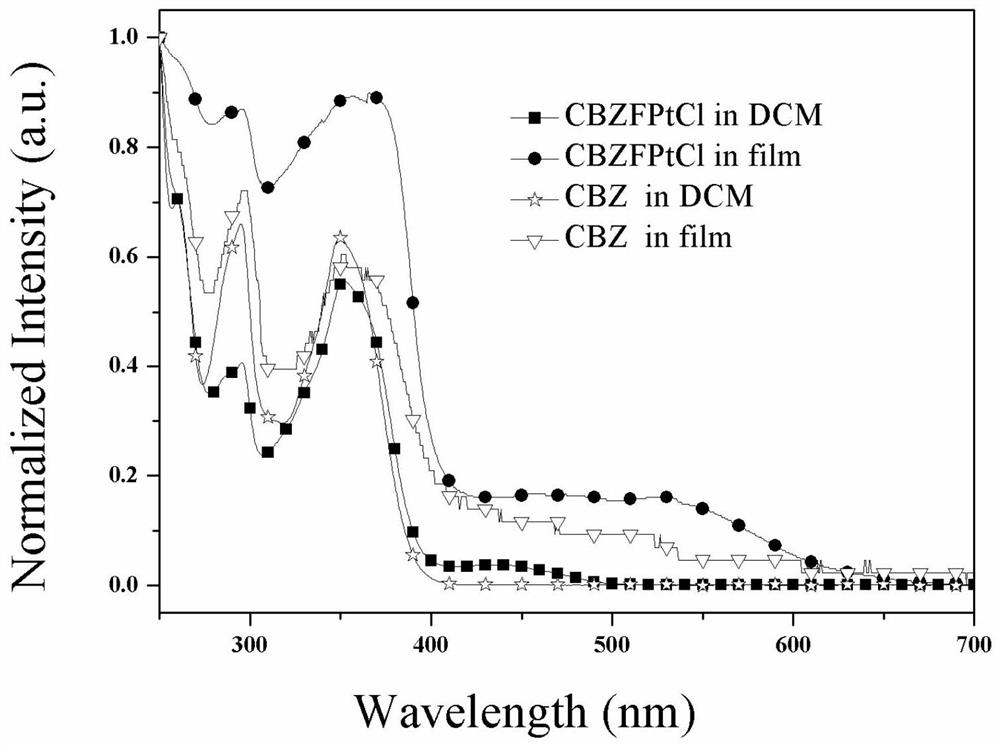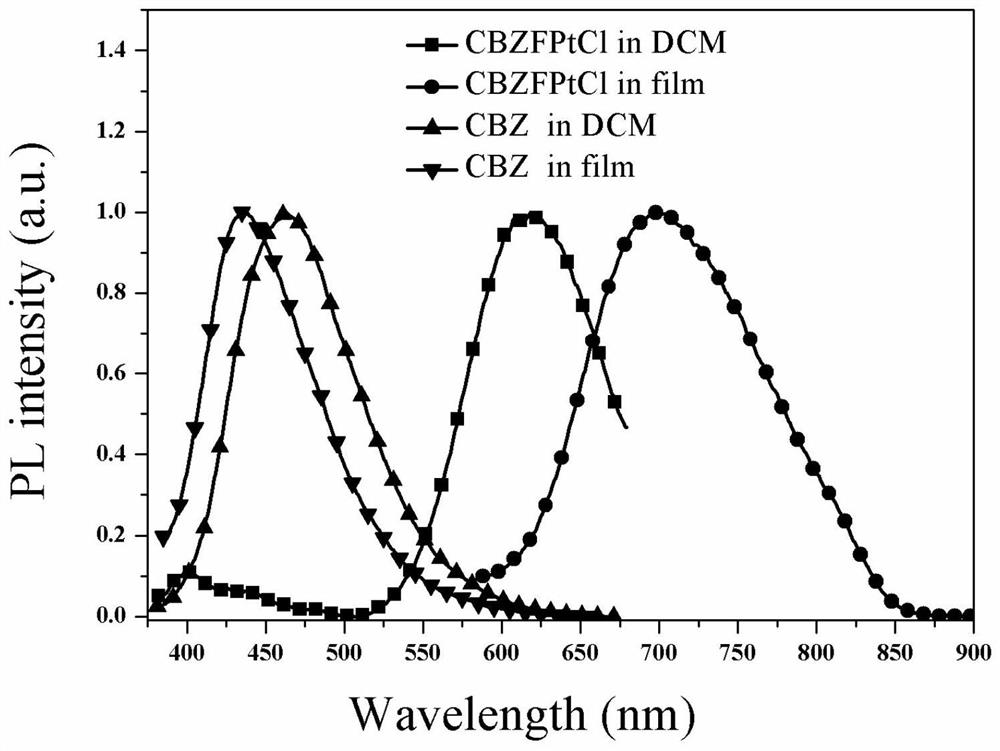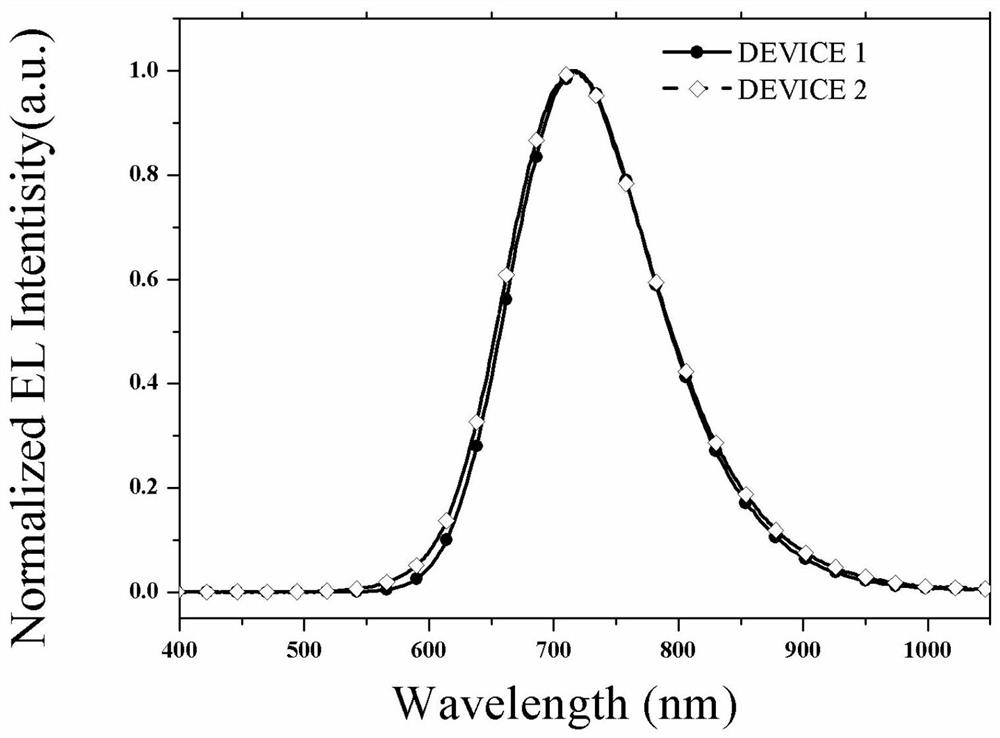Preparation and application of a class of binuclear cyclometal platinum(iii) complex near-infrared luminescent materials
A technology of luminescent materials and ring metals, applied in luminescent materials, platinum-based organic compounds, platinum-group organic compounds, etc., can solve the problems of low luminous efficiency and service life of electroluminescent devices, narrow selection range, roll-off of device luminous efficiency, etc. problems, to achieve excellent bipolar transmission performance, high-efficiency near-infrared emission, and improve the effect of exciton utilization
- Summary
- Abstract
- Description
- Claims
- Application Information
AI Technical Summary
Problems solved by technology
Method used
Image
Examples
Embodiment 1
[0048] Preparation of near-infrared luminescent material CBZFPtCl of ionic binuclear trivalent cyclometal platinum complex.
[0049] Its synthetic route is as follows:
[0050]
[0051] Preparation of Compound 1
[0052] To 150 mL of freshly distilled toluene, add 3,6 di-tert-butylcarbazole (2.79 g, 0.01 mol), methyl 4-iodobenzoate (3.14 g, 0.012 mol), tris(dibenzylideneacetone) di Palladium (92mg, 0.1mmol), potassium carbonate (2.76g, 0.02mol) and tri-tert-butylphosphine (10% toluene solution, 1.4mL) were heated under reflux and stirred for 24h under nitrogen protection. Cool to room temperature, filter, wash the filter residue with dichloromethane, collect the filtrate, distill off the solvent under reduced pressure, and the residue is an eluent with a mixed solvent of petroleum ether (PE) and dichloromethane (DCM) (PE:DCM=5: 1, V:V), separated by column chromatography to obtain 3.25g of white solid, yield: 78.6%. 1 HNMR (300MHz, CDCl 3 )δ8.26(d, J=9.9Hz, 2H), 8.15(s,...
Embodiment 2
[0061] UV-Vis Absorption Spectra Measurement of Ionic Binuclear Cyclometallic Platinum(III) Complex Near-infrared Luminescent Material CBZFPtCl
[0062] Dissolve CBZ and CBZFPtCl in DCM respectively to make 10 -5 M solution, test the ultraviolet-visible absorption spectrum of its solution or make CBZ and CBZFPtCl into thin films on quartz plates, and test the ultraviolet-visible absorption spectrum of its solid film. figure 1 It is the ultraviolet-visible absorption spectrum of CBZ, CBZFPtCl in solution and solid film.
[0063] Depend on figure 1 It can be seen that the ligand CBZ presents two absorption peaks in solution and solid, which are located at the short wavelength of 293nm and the long wavelength of 352nm respectively; the short wavelength absorption peak belongs to the transition absorption of the molecule π-π*; the long wavelength absorption peak belongs to Intramolecular charge transfer (ICT) from the donor unit to the acceptor unit. Comparing the UV-Vis absorp...
Embodiment 3
[0065] Photoluminescence Spectra Measurement of Ionic Binuclear Cyclometallic Platinum(III) Complex Near-infrared Luminescent Material CBZFPtCl
[0066] Dissolve CBZ and CBZFPtCl in DCM respectively to make 10 -5 M solution, test the fluorescence emission spectrum of the solution or make CBZ and CBZFPtCl thin films on the quartz plate respectively, and test the fluorescence emission spectrum of the solid film. figure 2 It is the fluorescence emission spectrum of auxiliary ligand CBZ and its near-infrared luminescent material CBZFPtCl in DCM and solid thin film.
[0067] Depend on figure 2 It can be seen that the maximum emission peaks of the ligand CBZ in the DCM solution and the solid film are 465nm and 437nm respectively, and the photoluminescence spectrum of the solid film is blue-shifted, which is different from that between the donor (D) and the acceptor (A) in the solid rigid medium. It is related to the prohibition of rotation distortion.
[0068]The maximum peak o...
PUM
 Login to View More
Login to View More Abstract
Description
Claims
Application Information
 Login to View More
Login to View More - R&D
- Intellectual Property
- Life Sciences
- Materials
- Tech Scout
- Unparalleled Data Quality
- Higher Quality Content
- 60% Fewer Hallucinations
Browse by: Latest US Patents, China's latest patents, Technical Efficacy Thesaurus, Application Domain, Technology Topic, Popular Technical Reports.
© 2025 PatSnap. All rights reserved.Legal|Privacy policy|Modern Slavery Act Transparency Statement|Sitemap|About US| Contact US: help@patsnap.com



